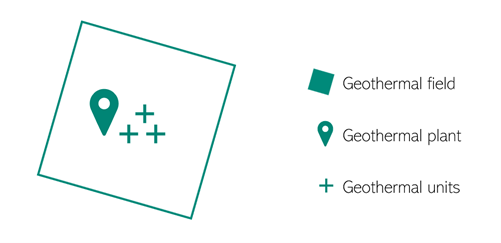Geothermal Power Data
Data Collection | Update for the World Geothermal Congress
February 2022 | International Geothermal Association
Authors: IGA Education & Information Committee, Chair – Adele Manzella
Margaret Krieger, IGA Associate Data & Policy Analyst
Overview
In January 2021 the International Geothermal Association (IGA) built a framework for geothermal data standards and methods to improve data collection and update the World Geothermal Congress (WGC) reporting. This work was led by the IGA Education and Information Committee with the goal to support the process of collecting, storing, and sharing coherent geothermal datasets.
In March 2021 two groups of experts were formed: one for geothermal power generation and one for geothermal heating and cooling. Each expert group had two sets of activities, categorized broadly as reviewing data standards and data management/analysis.
In November 2021 the work of the IGA experts was completed. Our results are revisions of power and heating and cooling dataset standards, including energy definitions, categories, direct use classification, and methods of data collection. These results are to be used as standards for the IGA data collection and for customized questionnaires for the World Geothermal Congresses Country Updates and proposed for reference to other organizations.
This report presents the updated power dataset and results of the IGA Power Expert Group.
Power Dataset
The following dataset presents categories, their definitions and calculations methods for three datasets, namely geothermal field, plant and unit.
Geothermal Field
| Power Categories | Definitions |
|---|---|
| Location: | Country |
| Geothermal field name (incl. previous field names) | Name of the geothermal reservoir/field as recognized by regulatory agencies (license, e.g.) or by its general use in the scientific/industrial literature. The field may produce fluid for multiple power plants with different names and operators (e.g. The Geysers). |
| Field operator | Name of the entity charged with operating the field (installing pipelines/separators, operating valves, drilling makeup wells, etc.). Field operator is the custodian, or the license holder consented and/or allowed to utilize the resource who has legal responsibility for its operation and management. |
| Type of geothermal system: ● Hot water ● Two-phase, liquid-dominated: ● Low enthalpy ● Medium enthalpy ● High enthalpy ● Two-phase, vapour-dominated | Consult the table of categories of geothermal systems (Kamila et al. 2021)* below to choose the appropriate type. |
| Number of wells drilled for an entire field over the period (2020, 2021, 2023, 2023) | The number of wells include full-sized production and injection wells, and slimholes over the period of the last calendar year. |
| Depth of the deepest production well [m] | – |
| Reservoir engineering system: ● Hydrothermal ● EGS ● Closed loop | Reservoir engineering systems refers to the extraction method: ● Hydrothermal Developed geothermal systems characterized by the natural transfer (esp. convection) of heat by fluid, either in liquid or vapor state, or mix thereof. ● EGS (Engineered Geothermal System) including Hot Dry Rock The system is characterized by the extraction of heat, via the creation of a connected subsurface fracture network by which fluid (typically water) is added via injection wells, and tapped via production wells for utilization at the ground surface. ● Closed loop Engineered piping system which allows circulated pumped fluid to move via an underground piping system (vertically or horizontally configured) to the surface in a continuous closed loop. |
*Categories of geothermal systems (Kamila et al. 2021). Full paper here.
| System Category | Temperature | Production Enthalpy | |
| Hot water | T < 220 °C | h < 943 kJ/kg | |
| Two-phase, liquid-dominated | Low enthalpy | 220 °C < T < 250 °C | 943 kJ/kg < h < 1100 kJ/kg |
| Medium enthalpy | 250 °C < T < 300 °C | 1100 kJ/kg < h < 1500 kJ/kg | |
| High enthalpy | 250 °C < T < 350 °C | 1500 kJ/kg < h < 2600 kJ/kg | |
| two-phase , vapour-dominated | 250 °C < T < 350 °C | 2600 kJ/kg < h < 2800 kJ/kg |
Geothermal Plant
| Power Categories | Definitions |
|---|---|
| Plant name | Current name of the plant as recognized by regulatory agencies (license, e.g.) or by its general use in the scientific/industrial literature. A plant may have multiple units (reported in the next section). |
| Plant operator, if different from field operator | Name of the company responsible for operation of the field (wells, pipelines, separators, etc.). May be the same or different from the Field Operator. If the same as the Field Operator, indicate “Same as Field Operator”. |
| Combined heat and power (CHP): ● Yes ● No | Indicate whether it is a combined heat (or cooling) and power plant. Details about heating and cooling production are to be provided under the Heating & Cooling Dataset. |
| Co-production: ● Yes ● No | Indicate if the field has a significant additional benefit stream from a source other than geothermal electricity or CHP, e.g. mineral recovery, oil and gas, hydrogen, etc. |
| Hybrid energy system: ● Yes ● No | Indicate if the field produces electricity from a source other than geothermal e.g. solar, biomass, etc. |
Geothermal Unit
| Power Categories | Definitions |
|---|---|
| Unit name (incl. previous names) | List the current and previous unit names. A unit is the sum of equipment associated with a turbine generator. If a power station has multiple units, list them separately. |
| Type of unit: ● 1F / 2F / 3F ● Dry Steam ● Back Pressure ● B-ORC ● B-Kalina ● Other (specify) | Type of unit refers to … ● 1F / 2F / 3F: steam turbines harnessing steam flashed from two-phase geofluid ● Dry Steam: steam turbines harnessing steam from a dry steam reservoir, no flash separation required ● Back Pressure: steam turbines exhausting to atmosphere, no condenser or cooling system ● B-ORC: Organic Rankine Cycle ● B-Kalina: Kalina Cycle using an ammonia-water mixture as a working fluid If it is a hybrid unit, please choose multiple types. |
| Year commissioned | Commercial operations date (COD, year) |
| Status: ● Operating ● under construction (within one year of commissioning) ● not operating temporarily ● decommissioned | – |
| Turbine Manufacturer | – |
| Installed Capacity [MW] | Equals installed nameplate capacity of a unit. The installed nameplate capacity is the full-load continuous gross capacity of a unit under specified conditions, as calculated from the electric generator nameplate based on the rated power factor (IEEE 762-2006). |
| Produced Energy gross [GWh/yr] | Gross Energy Produced is the sum of the electrical energy production by the unit concerned measured at the output terminals of the main generator (Eurostat, IEA, UNECE & OECD, 2012). |
| Produced Energy net [GWh/yr] | Net Energy Produced is equal to the gross Energy Produced less the electrical energy absorbed by the generating auxiliaries and the losses in the main generator transformers (Eurostat, IEA, UNECE & OECD, 2012). Produced energy net equals energy sold. |
Power Experts
- Jem Austria, Energy Development Corporation
- Greg Bignall, G&A Geothermal Advice Limited
- Guido Cappetti, Enel Green Power
- Füsun Tut Haklıdır, Istanbul Bilgi University
- William Harvey, Reykjavik University
- Eylem Kaya, University of Auckland
- Alexander Richter, Iceland Renewable Energy Cluster



